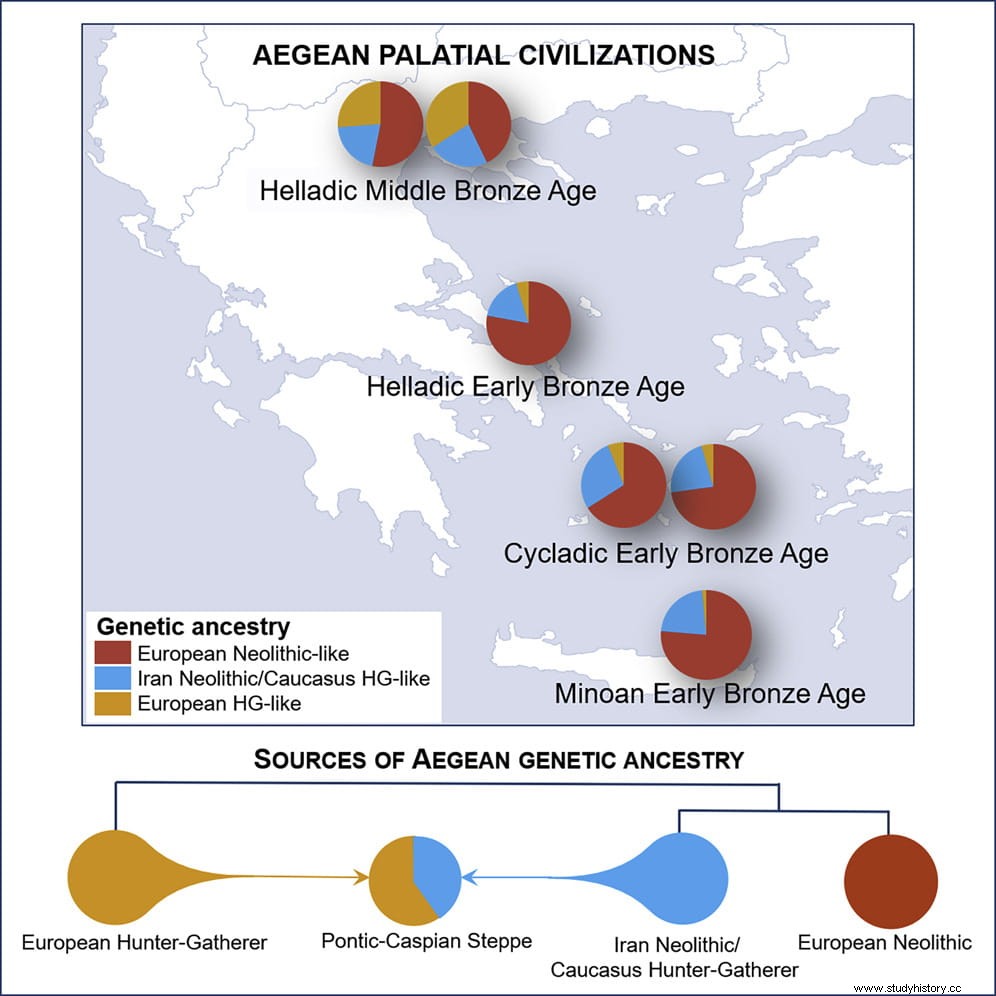The first civilizations that built monumental palaces and urban centers in Europe are more genetically homogeneous than expected, according to the first study to sequence complete genomes collected from ancient archaeological sites in the Aegean Sea. The study has been published in the journal Cell .
Despite marked differences in funerary customs, architecture, and art, the Minoan civilization of Crete, the Helladic civilization of mainland Greece, and the Cycladic civilization of the central Aegean islands were genetically similar during the early Bronze Age ( 5,000 years ago).
The findings are important because they suggest that critical innovations such as the development of urban centers, the use of metals, and intensive trade made during the transition from the Neolithic to the Bronze Age were not due solely to mass immigration from the eastern Aegean, as previously thought, but also to the cultural continuity of local Neolithic groups.
The study also reveals that in the Middle Bronze Age (4,000–4,600 years ago), individuals in the North Aegean were considerably different from those in the Early Bronze Age. These individuals shared half of their ancestry with the inhabitants of the Pontic-Caspian steppe, a large geographic region stretching between the Danube and Ural rivers and north of the Black Sea, and were very similar to modern-day Greeks.
The findings suggest that migratory waves of herders from the Pontic-Caspian steppe, or North Aegean populations having similar ancestry to the Pontic-Caspian steppe, shaped present-day Greece. All these possible migratory waves predate the appearance of the first documented form of Greek, which supports the theories that explain the appearance of Proto-Greek and the evolution of Indo-European languages in Anatolia or in the Pontic-Caspian steppe region.
The team sampled well-preserved bone remains at archaeological sites. They sequenced six complete genomes, four from three Early Bronze Age cultures and two from a Middle Bronze Age Helladic culture.
The researchers also sequenced the mitochondrial genomes of eleven other individuals from the First Bronze Age. Whole genome sequencing provided enough data to perform demographic and statistical analyzes on population histories.

According to Oscar Lao, Head of the Population Genomics Group at CNAG-CRG, taking advantage of the fact that the number of samples and the quality of the DNA we find is enormous for this type of study, we have developed sophisticated machine learning tools to overcome challenges such as low coverage depth, damage and modern human contamination, opening the door to the application of artificial intelligence to paleogenomic data .
Implementing deep learning in demographic inference based on ancient samples allowed us to reconstruct ancestral relationships between ancient populations and reliably infer the number and timing of mass migration events that marked the cultural transition from the Neolithic to the Middle Ages. Bronze Age in the Aegean , affirms Olga Dolgova, postdoctoral researcher in the Population Genomics Group of the CNAG-CRG.
The Bronze Age in Eurasia was marked by fundamental social, political and economic changes, visible in the appearance of the first great urban centers and monumental palaces. The growing economic and cultural exchange that developed during this time laid the foundation for modern economic systems such as capitalism, long-distance political deals, and the world trade economy.
Despite its importance for understanding the rise of European civilizations and the spread of Indo-European languages, the genetic origins of the peoples behind the transition from the Neolithic to the Bronze Age and their contribution to the current Greek population remain unknown. being controversial.
Future studies could investigate complete genomes between Mesolithic and Bronze Age Armenia and the Caucasus to help pinpoint the origins of the Aegean migration, and to better integrate the genomic data with existing archaeological and linguistic evidence.
